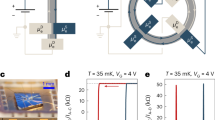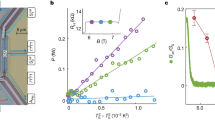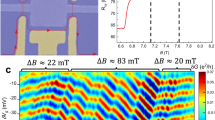Abstract
The electrical resistance of a conductor is intimately related to the relaxation of the momentum of charge carriers. In a simple model, the accelerating force exerted on electrons by an applied electric field is balanced by a frictional force arising from their frequent collisions with obstacles such as impurities, grain boundaries or other deviations from a perfect crystalline order1. Thus, in the absence of any scattering, the electrical resistance should vanish altogether. Here, we observe such vanishing four-terminal resistance in a single-mode ballistic quantum wire. This result contrasts the value of the standard two-probe resistance measurements of h/2e2≈ 13 kΩ. The measurements are conducted in the highly controlled geometry afforded by epitaxial growth onto the cleaved edge of a high-quality GaAs/AlGaAs heterostructure. Two weakly invasive voltage probes are attached to the central section of a ballistic quantum wire to measure the inherent resistance of this clean one-dimensional conductor.
This is a preview of subscription content, access via your institution
Access options
Subscribe to this journal
Receive 51 print issues and online access
$199.00 per year
only $3.90 per issue
Buy this article
- Purchase on Springer Link
- Instant access to full article PDF
Prices may be subject to local taxes which are calculated during checkout



Similar content being viewed by others
References
Drude, P. Zur elektronentheori der metalles 1 Teil. Ann. Phys. 1, 566–613 (1900); Zur elektronentheori der metalles 2 Teil, Galvanomagnetische und thermomagnetisch effecte. Ann. Phys. 3, 369–402 (1900).
Heiblum, M. Tunneling hot electron transfer amplifiers (THETA): Amplifiers operating up to the infrared. Solid State Electron. 24, 343–366 (1981).
van Wees, B. J. et al. Quantized conductance of point contacts in a two-dimensional electron gas. Phys. Rev. Lett. 60, 848–850 (1988).
Wharam, D. A. et al. One-dimensional transport and the quantisation of the ballistic resistance. J. Phys. C 21, L209–L214 (1988).
van Houten, H. et al. Coherent electron focusing with quantum point contacts in a two-dimensional electron gas. Phys. Rev. B 39, 8556–8575 (1989).
Tarucha, S., Honda, T. & Saku, T. Reduction of quantized conductance at low temperature observed in 2 to 10 µm long quantum wires. Solid State Commun. 94, 413–418 (1995).
Yacoby, A. et al. Nonuniversal conductance quantization in quantum wires. Phys. Rev. Lett. 77, 4612–4615 (1996).
Rother, M., Wegscheider, W., Bichler, M. & Abstreiter, G. in Proc. of ICPS24 Vol. 2 (ed. Gershoni, D.) Th-P137 (World Scientific, Singapore, 1998).
Imry, Y. in Introduction to Mesoscopic Physics (eds Craighead, H. G. et al.) 89–120 (Oxford Univ. Press, Oxford, 1997).
Landauer, R. Spatial variations of currents and fields due to localized scatterers in metallic conduction. IBM J. Res. Dev. 1, 223–231 (1957).
Landauer, R. Electrical resistance of disordered one-dimensional lattices. Phil. Mag. 21, 863–867 (1970).
Imry, Y. in Directions in Condensed Matter Physics (eds Grinstein, G. & Mazenko, G.) (World Scientific, Singapore, 1986).
Glazman, L. I., Lesovik, G. B. D., Khmel’nitskii, E. & Shekhter, R. I. Reflectionless quantum transport and fundamental ballistic-resistance steps in microscopic constrictions. JEPT Lett. 48, 238–241 (1988).
Pfeiffer, L. N. et al. Transport and optics in quantum wires fabricated by MBE overgrowth on the 〈110〉 cleaved edge. Microelectron. J. 28, 817–823 (1997).
Engquist, H. L. & Anderson, P. W. Definition and measurement of the electrical and thermal resistances. Phys. Rev. B 24, 1151–1154 (1981).
Buttiker, M. Four-terminal phase-coherent conductance. Phys. Rev. Lett. 57, 1761–1764 (1986).
Buttiker, M. Role of quantum coherence in series resistors. Phys. Rev. B 33, 3020–3026 (1986).
Buttiker, M. Symmetry of electrical conduction. IBM J. Res. Dev. 32, 317–323 (1988).
de Picciotto, R. et al. 2D-1D coupling in cleaved edge overgrowth. Phys. Rev. Lett. 85, 1730–1733 (2000).
Acknowledgements
We thank A. L. Moustakas, S. H. Simon, A. Yacoby and C. M. Varma for fruitful discussions.
Author information
Authors and Affiliations
Corresponding author
Rights and permissions
About this article
Cite this article
de Picciotto, R., Stormer, H., Pfeiffer, L. et al. Four-terminal resistance of a ballistic quantum wire. Nature 411, 51–54 (2001). https://doi.org/10.1038/35075009
Received:
Accepted:
Issue Date:
DOI: https://doi.org/10.1038/35075009
This article is cited by
-
A semiclassical approach to the magnetotransport in quasi-1D electron systems
Applied Physics A (2023)
-
An epitaxial graphene platform for zero-energy edge state nanoelectronics
Nature Communications (2022)
-
Review of contact-resistance analysis in nano-material
Journal of Mechanical Science and Technology (2018)
-
Exceptional ballistic transport in epitaxial graphene nanoribbons
Nature (2014)
-
Electrostatic potential profile and nonlinear current in an interacting one-dimensional molecular wire
Journal of Chemical Sciences (2003)
Comments
By submitting a comment you agree to abide by our Terms and Community Guidelines. If you find something abusive or that does not comply with our terms or guidelines please flag it as inappropriate.



